check engine RENAULT ESPACE 2000 J66 / 3.G Technical Note 3426A Workshop Manual
[x] Cancel search | Manufacturer: RENAULT, Model Year: 2000, Model line: ESPACE, Model: RENAULT ESPACE 2000 J66 / 3.GPages: 52, PDF Size: 0.98 MB
Page 6 of 52
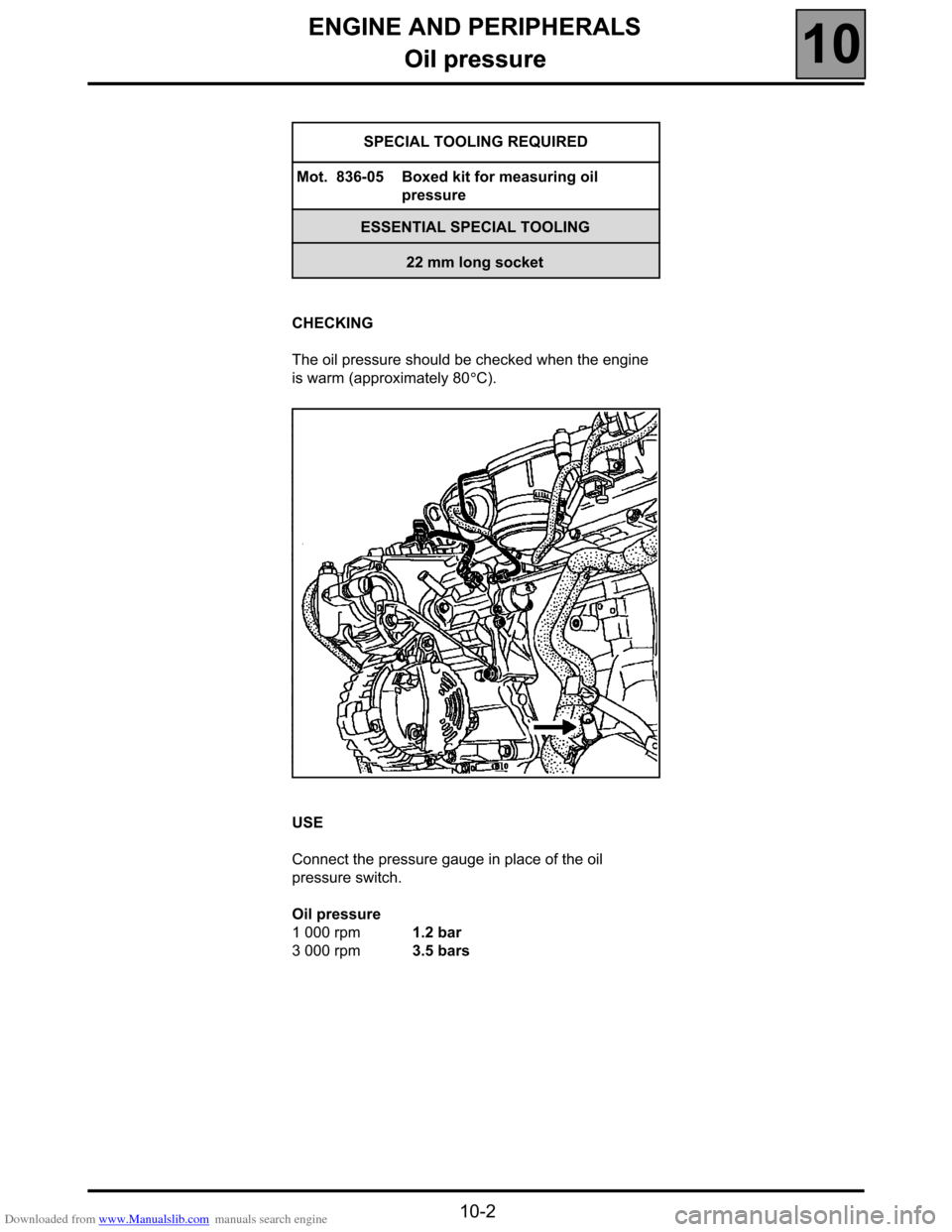
Downloaded from www.Manualslib.com manuals search engine ENGINE AND PERIPHERALS
Oil pressure
10
10-2
Oil pressure
CHECKING
The oil pressure should be checked when the engine
is warm (approximately 80°C).
USE
Connect the pressure gauge in place of the oil
pressure switch.
Oil pressure
1 000 rpm 1.2 bar
3 000 rpm 3.5 bars SPECIAL TOOLING REQUIRED
Mot. 836-05 Boxed kit for measuring oil
pressure
ESSENTIAL SPECIAL TOOLING
22 mm long socket
Page 13 of 52
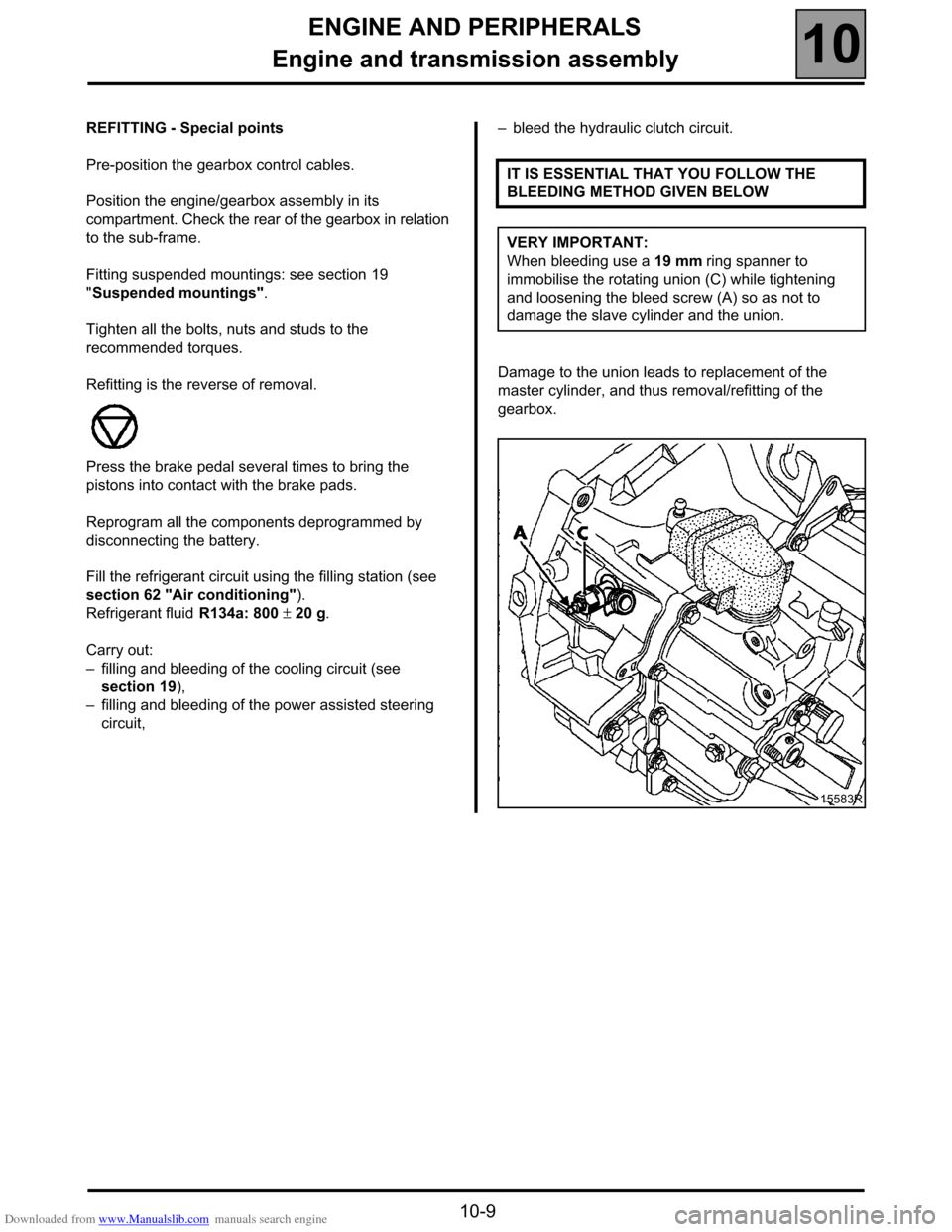
Downloaded from www.Manualslib.com manuals search engine ENGINE AND PERIPHERALS
Engine and transmission assembly
10
10-9
REFITTING - Special points
Pre-position the gearbox control cables.
Position the engine/gearbox assembly in its
compartment. Check the rear of the gearbox in relation
to the sub-frame.
Fitting suspended mountings: see section 19
"Suspended mountings".
Tighten all the bolts, nuts and studs to the
recommended torques.
Refitting is the reverse of removal.
Press the brake pedal several times to bring the
pistons into contact with the brake pads.
Reprogram all the components deprogrammed by
disconnecting the battery.
Fill the refrigerant circuit using the filling station (see
section 62 "Air conditioning").
Refrigerant fluid R134a: 800 ± 20 g.
Carry out:
–filling and bleeding of the cooling circuit (see
section 19),
–filling and bleeding of the power assisted steering
circuit,–bleed the hydraulic clutch circuit.
Damage to the union leads to replacement of the
master cylinder, and thus removal/refitting of the
gearbox.IT IS ESSENTIAL THAT YOU FOLLOW THE
BLEEDING METHOD GIVEN BELOW
VERY IMPORTANT:
When bleeding use a 19 mm ring spanner to
immobilise the rotating union (C) while tightening
and loosening the bleed screw (A) so as not to
damage the slave cylinder and the union.
15583R
Page 14 of 52

Downloaded from www.Manualslib.com manuals search engine ENGINE AND PERIPHERALS
Engine and transmission assembly
10
10-10
BLEEDING METHOD TO BE USED:
(for two people).
1) Filling the circuit:
Check that the clutch pedal is in the top position; put
it in this position and hold it by hand if necessary.
Fill the hydraulic circuit by connecting a filling system
and applying pressure to the tank, open the bleed
screw (A) (always compensate for the force using a
counter-spanner) and allow a little fluid to escape
(approximately 0.5 l) through a transparent tube
connected to the bleed screw. Close the bleed
screw.
2) Final bleeding of the circuit:
One operator slowly disengages fully and keeps the
pedal depressed. Wait approximately ten seconds in
this situation. With the pedal still depressed, a
second operator opens the bleed screw briefly (A).
With the bleed screw closed again, the operator
inside the vehicle releases the clutch pedal and
slowly lifts it to top position by hand (It is normal that
the pedal does not return independently in this
configuration).
After a few seconds repeat the operations described
above in 2) as often as required until no more
bubbles escape when bleeding. Then repeat these
operations five times to ensure that the system has
been bled correctly.
These repeated bleedings allow the slave cylinder to
eject all the air trapped in any section between the
stop and the bleed screw and which has not been
"cleaned" by the flow of liquid when refilling using the
traditional pressurisation system.
An air bubble in the circuit, no matter how small, may
lead to operating faults such as: incorrect pedal
return, crashing of the gears,..., which may lead to
incorrect fault finding and unnecessary replacement
of a component in the clutch circuit.
Page 17 of 52
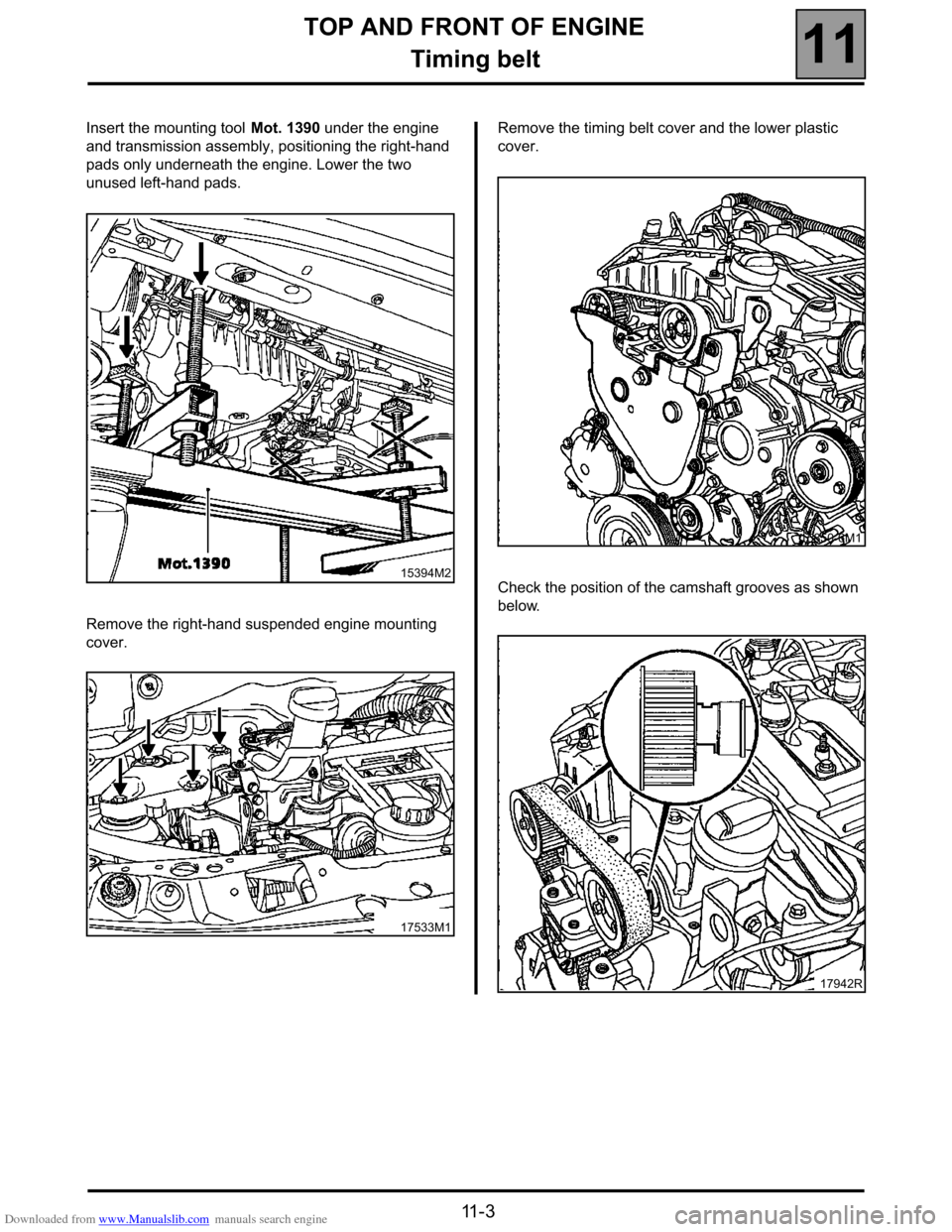
Downloaded from www.Manualslib.com manuals search engine TOP AND FRONT OF ENGINE
Timing belt
11
11 - 3
Insert the mounting tool Mot. 1390 under the engine
and transmission assembly, positioning the right-hand
pads only underneath the engine. Lower the two
unused left-hand pads.
Remove the right-hand suspended engine mounting
cover.Remove the timing belt cover and the lower plastic
cover.
Check the position of the camshaft grooves as shown
below.
15394M2
17533M1
15850-6M1
17942R
Page 19 of 52
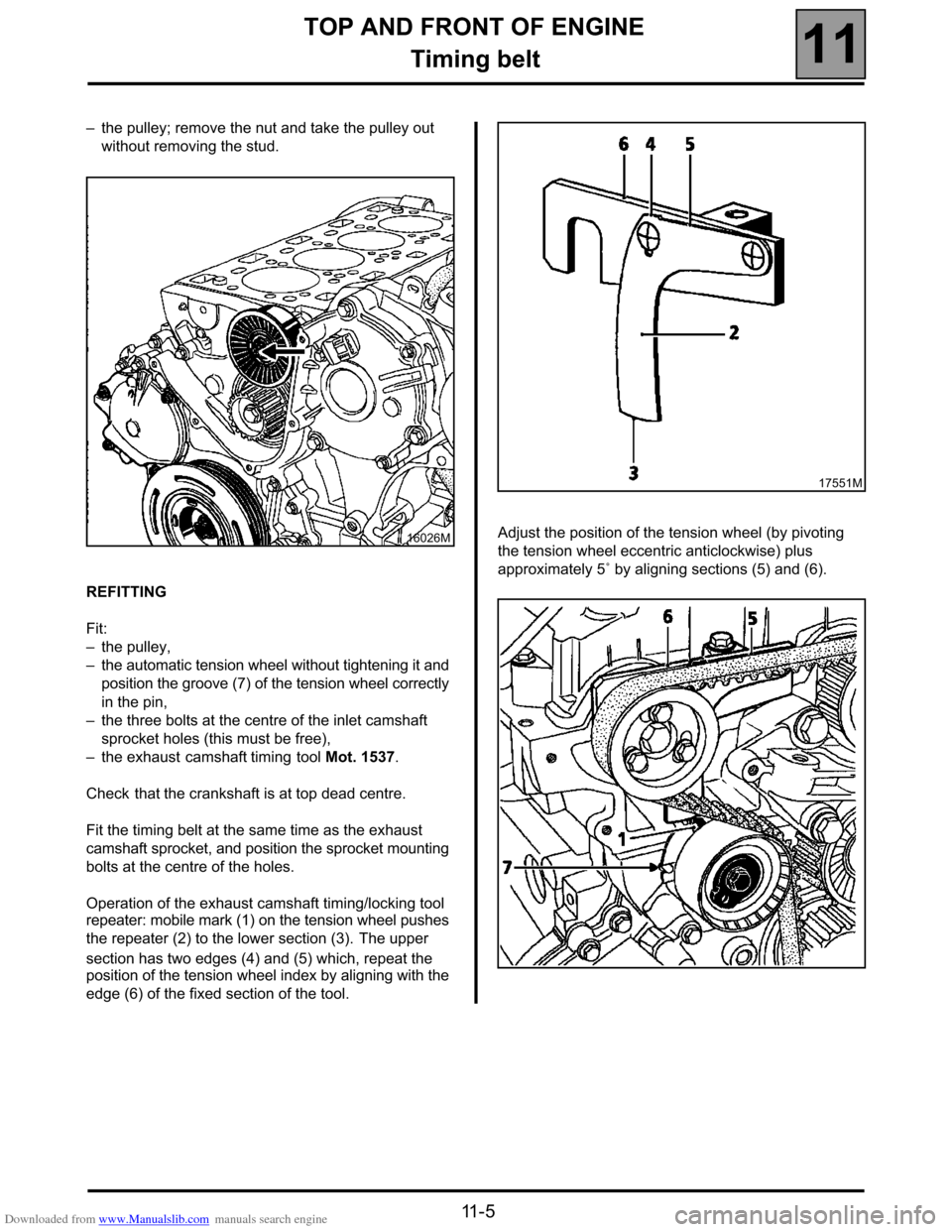
Downloaded from www.Manualslib.com manuals search engine TOP AND FRONT OF ENGINE
Timing belt
11
11 - 5
–the pulley; remove the nut and take the pulley out
without removing the stud.
REFITTING
Fit:
–the pulley,
–the automatic tension wheel without tightening it and
position the groove (7) of the tension wheel correctly
in the pin,
–the three bolts at the centre of the inlet camshaft
sprocket holes (this must be free),
–the exhaust camshaft timing tool Mot. 1537.
Check that the crankshaft is at top dead centre.
Fit the timing belt at the same time as the exhaust
camshaft sprocket, and position the sprocket mounting
bolts at the centre of the holes.
Operation of the exhaust camshaft timing/locking tool
repeater: mobile mark (1) on the tension wheel pushes
the repeater (2) to the lower section (3). The upper
section has two edges (4) and (5) which, repeat the
position of the tension wheel index by aligning with the
edge (6) of the fixed section of the tool.Adjust the position of the tension wheel (by pivoting
the tension wheel eccentric anticlockwise) plus
approximately 5˚ by aligning sections (5) and (6).
16026M
17551M
Page 20 of 52
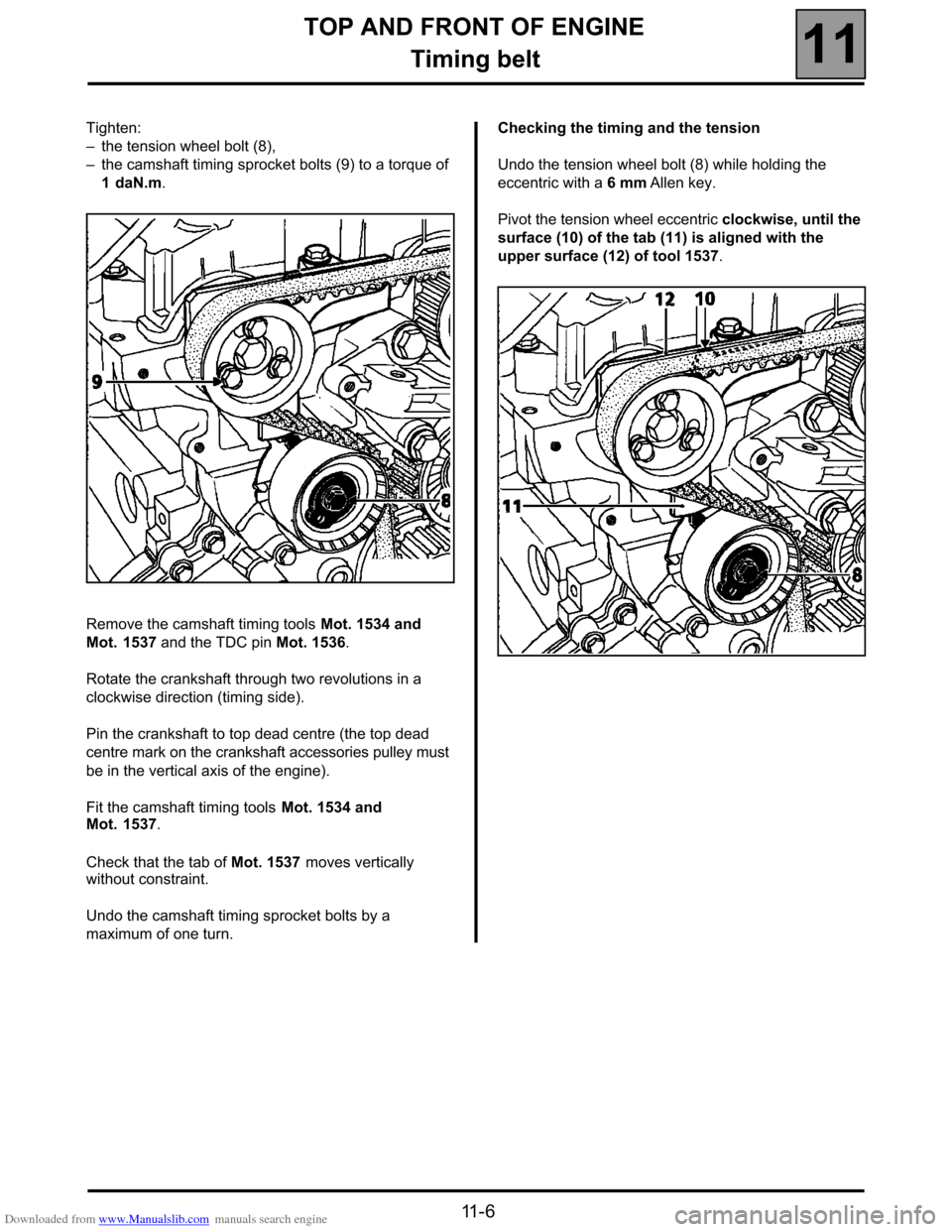
Downloaded from www.Manualslib.com manuals search engine TOP AND FRONT OF ENGINE
Timing belt
11
11 - 6
Tighten:
–the tension wheel bolt (8),
–the camshaft timing sprocket bolts (9) to a torque of
1 daN.m.
Remove the camshaft timing tools Mot. 1534 and
Mot. 1537 and the TDC pin Mot. 1536.
Rotate the crankshaft through two revolutions in a
clockwise direction (timing side).
Pin the crankshaft to top dead centre (the top dead
centre mark on the crankshaft accessories pulley must
be in the vertical axis of the engine).
Fit the camshaft timing tools Mot. 1534 and
Mot. 1537.
Check that the tab of Mot. 1537 moves vertically
without constraint.
Undo the camshaft timing sprocket bolts by a
maximum of one turn. Checking the timing and the tension
Undo the tension wheel bolt (8) while holding the
eccentric with a 6 mm Allen key.
Pivot the tension wheel eccentric clockwise, until the
surface (10) of the tab (11) is aligned with the
upper surface (12) of tool 1537.
Page 24 of 52
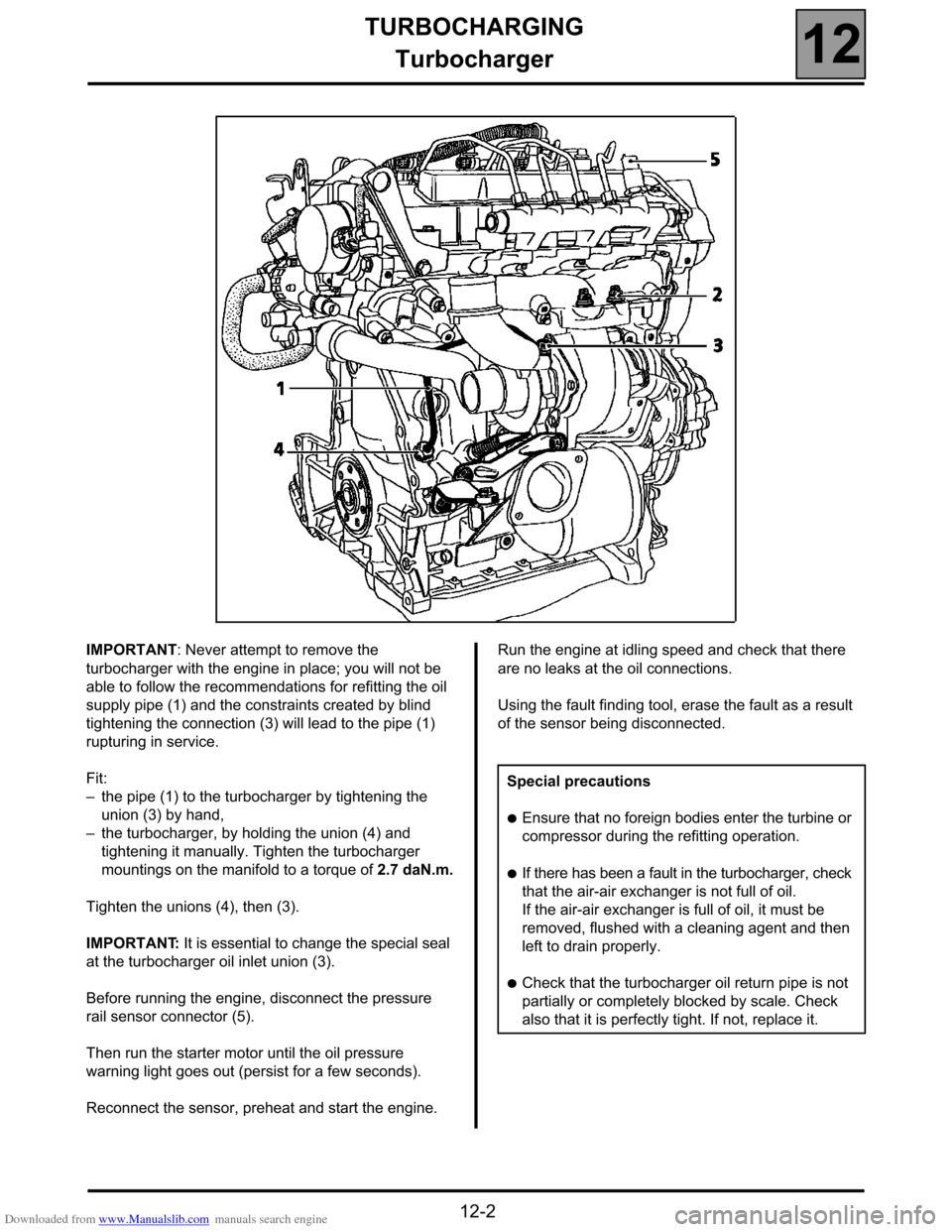
Downloaded from www.Manualslib.com manuals search engine TURBOCHARGING
Turbocharger
12
12-2
IMPORTANT: Never attempt to remove the
turbocharger with the engine in place; you will not be
able to follow the recommendations for refitting the oil
supply pipe (1) and the constraints created by blind
tightening the connection (3) will lead to the pipe (1)
rupturing in service.
Fit:
–the pipe (1) to the turbocharger by tightening the
union (3) by hand,
–the turbocharger, by holding the union (4) and
tightening it manually. Tighten the turbocharger
mountings on the manifold to a torque of 2.7 daN.m.
Tighten the unions (4), then (3).
IMPORTANT: It is essential to change the special seal
at the turbocharger oil inlet union (3).
Before running the engine, disconnect the pressure
rail sensor connector (5).
Then run the starter motor until the oil pressure
warning light goes out (persist for a few seconds).
Reconnect the sensor, preheat and start the engine.Run the engine at idling speed and check that there
are no leaks at the oil connections.
Using the fault finding tool, erase the fault as a result
of the sensor being disconnected.
Special precautions
●Ensure that no foreign bodies enter the turbine or
compressor during the refitting operation.
●If there has been a fault in the turbocharger, check
that the air-air exchanger is not full of oil.
If the air-air exchanger is full of oil, it must be
removed, flushed with a cleaning agent and then
left to drain properly.
●Check that the turbocharger oil return pipe is not
partially or completely blocked by scale. Check
also that it is perfectly tight. If not, replace it.
Page 28 of 52
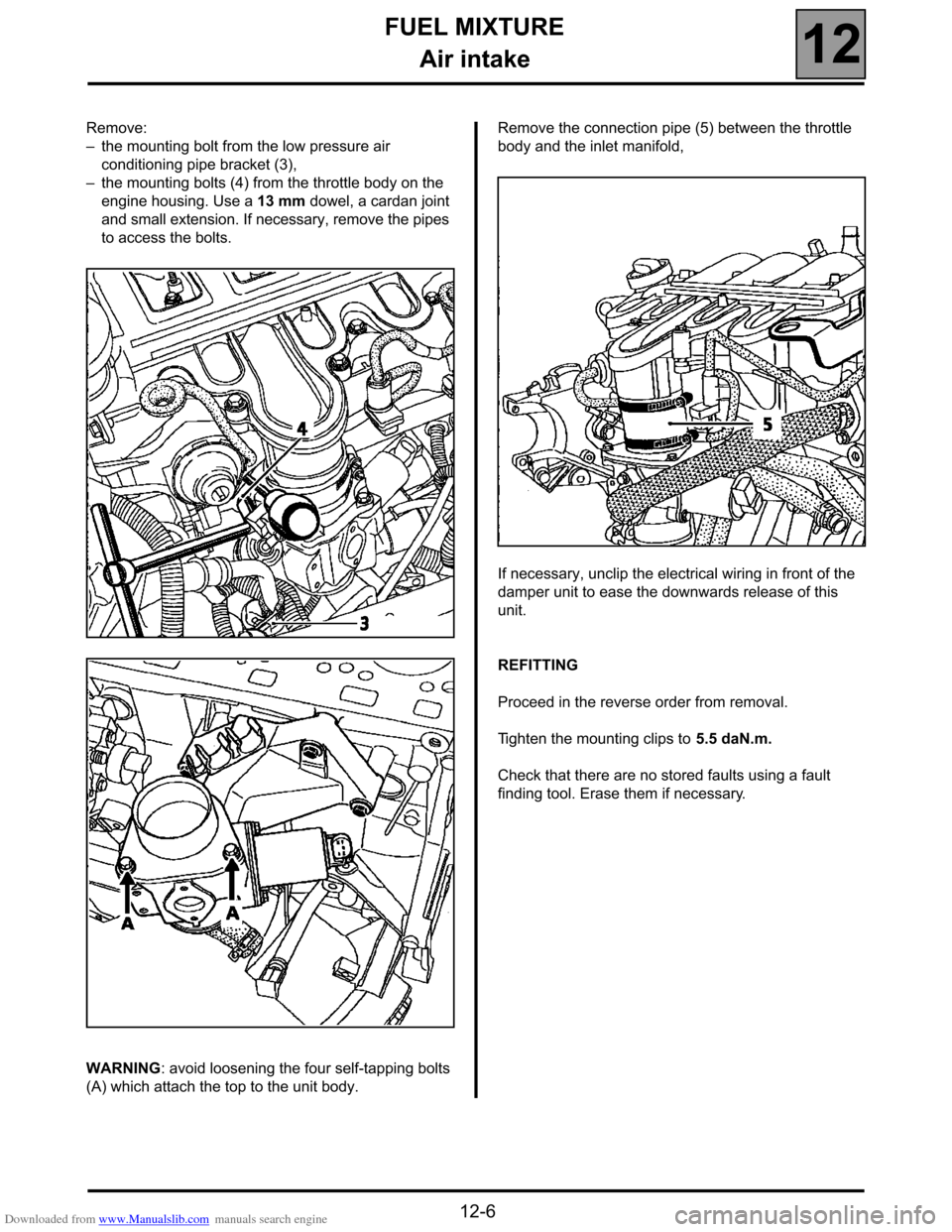
Downloaded from www.Manualslib.com manuals search engine FUEL MIXTURE
Air intake
12
12-6
Remove:
–the mounting bolt from the low pressure air
conditioning pipe bracket (3),
–the mounting bolts (4) from the throttle body on the
engine housing. Use a 13 mm dowel, a cardan joint
and small extension. If necessary, remove the pipes
to access the bolts.
WARNING: avoid loosening the four self-tapping bolts
(A) which attach the top to the unit body.Remove the connection pipe (5) between the throttle
body and the inlet manifold,
If necessary, unclip the electrical wiring in front of the
damper unit to ease the downwards release of this
unit.
REFITTING
Proceed in the reverse order from removal.
Tighten the mounting clips to 5.5 daN.m.
Check that there are no stored faults using a fault
finding tool. Erase them if necessary.
Page 32 of 52

Downloaded from www.Manualslib.com manuals search engine STARTING - CHARGING
Alternator
16
116STARTING - CHARGING
Alternator
IDENTIFICATION
CHECKING
After 15 minutes warming up at a voltage of 13.5 volts.Type Engine Alternator Current
JE0 K
JE0 SG9T VALEO SG 12 125 A
Rpm Amps
1500 26 A
4000 94 A
6000 105 A
16-1
Page 37 of 52

Downloaded from www.Manualslib.com manuals search engine COOLING SYSTEM
Filling and bleeding
19
119COOLING SYSTEM
Filling and bleeding
There is continuous circulation in the heater matrices.
FILLING
It is essential to open the two bleed screws at the
top of the radiator and the cylinder head coolant
pipe housing outlet.
Fill the circuit through the expansion bottle opening.
Close the bleed screws as soon as the liquid starts to
flow in a continuous stream.
Start the engine (2 500 rpm).
Adjust the level by overflow for a period of about
4 minutes.
Close the bottle.
BLEEDING
Allow the engine to run for about 20 minutes at
2 500 rpm, until the engine fans(s) operate (time
necessary for automatic degassing).
Check the liquid level is at the "Maximum" marker.
DO NOT OPEN THE BLEED SCREWS WHILST THE
ENGINE IS RUNNING.
REFIT THE EXPANSION BOTTLE CAP WHILE THE
ENGINE IS WARM.
19-1